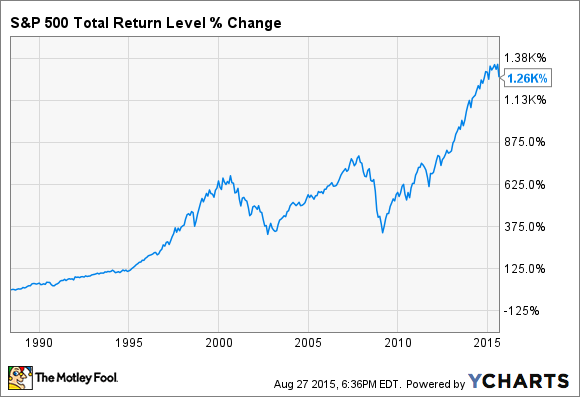
Photo: Vincerama at the German language Wikipedia
With the stock market rallying over the past few days, it appears that the correction might be over as quickly as it started. Maybe it is, but maybe not -- nobody knows for sure. Either way, long-term investors shouldn't concern themselves with this (or any other) market correction or crash. If history is any indicator, you'll be just fine -- even if you time the market completely wrong.
The worst possible times to invest for the long term
Over the past three decades, there are three clear points in the S&P 500 when it would have been the worst possible times to buy stocks.
- In August 1987, the index peaked at 336 approximately two months before Black Monday. The index bottomed on Monday, October 19, 1987 at 225 -- an overall drop of 33% from the peak.
- In March 2000, the S&P peaked at 1527 before the tech bubble burst and sent the index crashing down to 777 in October 2002, a massive 49% plunge.
- Most recently, the S&P 500 peaked at 1562 in October 2007 before the financial crisis sent the economy into a panic and the stock market into a tailspin -- finally bottoming out at 683 in March 2009 -- an unprecedented 56% plunge.
Now, before I dive deeper into this history lesson, let me clarify what I mean by a long-term investor. I assume that when you invest, you're in it for the long-haul -- which I'll assume means that you have a timeframe of at least 20 years until retirement, or until you'll need to use the money.
I'll also assume that you maintain a diversified portfolio, which means an assortment of different stocks (or funds) covering different industries. Obviously, if 100% of your portfolio was in bank stocks before the financial crisis, you would not have fared well in the subsequent years. Similarly, if all of your money was invested in momandpops.com in 2000, you probably got hit pretty hard.
How these unfortunate long-term investors fared
Even if you bought at one of these three unfortunate points in market history, you may be surprised to learn how you would have done. Let's look at how an investment in a simple S&P 500 index fund would have performed in the years since.
First, if you had bought at the 2007 peak, your investment would have rebounded in the post-crisis years. In fact, even after the recent market declines, you'd still be sitting on a 53% total return today. Not bad for waiting out one of the worst banking and real estate crises in history.
Next, what about if you had bought at the peak of the dot-com bubble? Sure, any individual tech stocks you may have owned probably got clobbered, but an S&P index fund would have rebounded and then some, producing a 75% total return. Now, I know that's not a great return over 15 years, but the 2000's were a particularly harsh period of time to be an investor.
Finally, how about those who bought prior to the 1987 crash? Even though your investment would have seen the ups and downs of three of the worst stock market crashes in modern history, you would be looking at a total return of more than 1,250% today, or an average of 9.3% annualized.
Now, these returns may not look too appealing (especially the first two cases), but bear in mind that unless you bought at the exact worst possible times, your long-term returns would likely be far superior to those discussed here.
Just follow these three rules, and market crashes will just be bumps in the road
Investors shouldn't worry too much about their long-term performance as long as these three rules are followed.
- Diversify -- You should own a variety of stocks in different industries. In my opinion, if you can't afford to own at least a dozen individual stocks, the bulk of your portfolio should be in index funds to ensure you're properly diversified and not susceptible to any sector-specific weakness (like the tech bubble or financial crisis).
- Don't buy all at once -- The key to successful long-term investing is to buy a little at a time, even if you can afford to buy large quantities of stock at once. Through the principle of dollar-cost averaging, by spreading your investments out, you're mathematically guaranteed to buy more shares when prices are low and fewer shares when prices are high.
- Buy low, sell high -- This may sound like the most obvious statement of the day, but too many investors do the exact opposite. When prices are going through the roof, they see how much money other people are making and buy stocks. Then, they panic and sell their stocks cheaply when the market begins to crash. The smartest thing you can do during a crash is to buy, or to simply hang on if you're not comfortable putting more money in -- but don't sell.
The takeaway
Long-term investors don't need to be afraid of crashes or corrections, nor should they try to invest at the "best" times. Rather, as long as you use a disciplined investment strategy, properly diversify your portfolio, and don't make any rash decisions with your stocks, it's always a smart time to buy.







